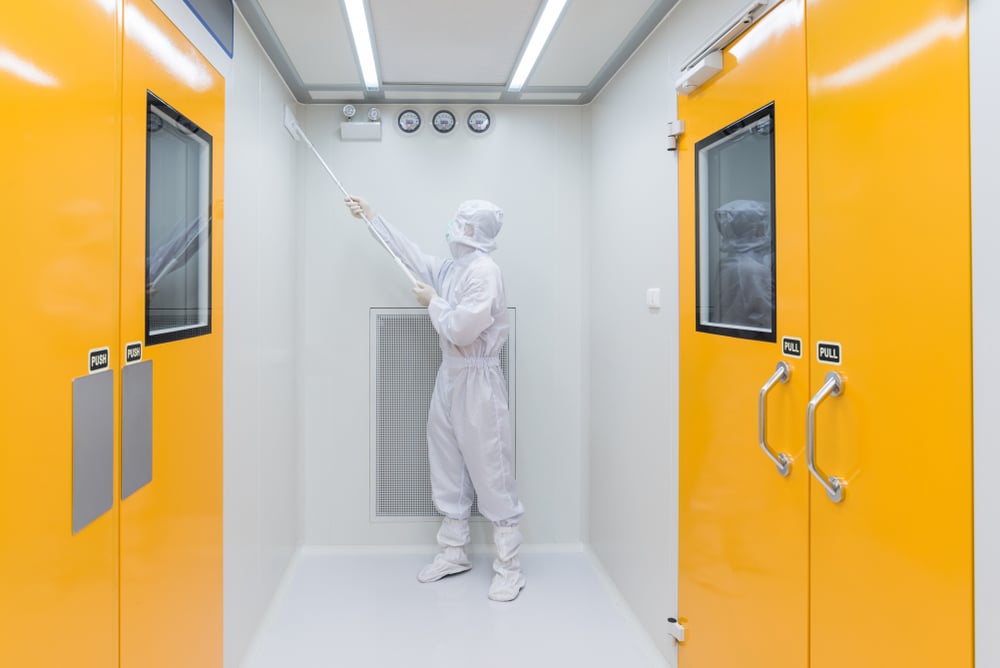Top 4 Sources of Cleanroom Contamination (and How to Prevent Them)

Maintaining control in a cleanroom is a delicate balance — one that can be easily disrupted by unseen contaminants. Even the smallest particle, trace chemical, or bacterial cell can compromise product integrity, delay production, or trigger costly compliance failures.
Understanding where contamination comes from, and how to prevent it, is the foundation of an effective contamination control program. Below, we’ll explore the top sources of cleanroom contamination and outline practical strategies to minimize risks and maintain the highest standards of cleanliness and performance.
1. Personnel Contamination: The Leading Culprit
Humans are the single largest source of cleanroom contamination. Every movement, breath, or improperly secured garment can release thousands of particles into the air. From skin flakes and hair to microorganisms and fibers, people can introduce contaminants simply by entering or working inside a cleanroom.
Why It’s a Risk
Even with protective clothing, humans constantly generate particulates through motion, speaking, and natural skin shedding. Without strict protocols, these contaminants can compromise sensitive operations such as pharmaceutical compounding, semiconductor manufacturing, or medical device assembly.
How to Prevent It
- Implement strict gowning procedures: Workers should follow step-by-step gowning protocols in designated areas, donning garments in the correct sequence to minimize contamination risk.
- Use high-quality cleanroom garments: Lint-free, static-dissipative apparel designed for the cleanroom class helps reduce particle shedding.
- Provide ongoing training: Regularly refresh employees on contamination control principles, correct gowning practices, and the importance of discipline when inside the cleanroom.
- Monitor compliance: Routine audits and surveillance help ensure that standards are consistently met.
A contamination-control mindset starts with personnel. Every team member should understand their role in maintaining the environment’s integrity.
2. Equipment Contamination: Oversights in Maintenance and Handling
Equipment used within cleanrooms, ranging from manufacturing tools to carts and monitors, can also be a significant contamination source if not properly maintained.
Why It’s a Risk
Particles can accumulate on machinery, tools, and work surfaces, especially if they’re not constructed from cleanroom-compatible materials or are introduced from uncontrolled areas. Vibrations, friction, and regular use can release particles or residues into the air.
How to Prevent It
- Choose cleanroom-compatible materials: Stainless steel and non-porous plastics are preferred over materials that shed or corrode.
- Establish a maintenance schedule: Regular cleaning, calibration, and inspection of all equipment help ensure performance and prevent buildup of particulates or residues.
- Control equipment entry: Items entering the cleanroom should pass through airlocks or pass-through chambers and be wiped down with approved solvents before entry.
- Minimize movement: Reducing necessary equipment transport between zones lowers the risk of cross-contamination.
Maintaining the integrity of cleanroom equipment is just as important as maintaining air cleanliness. Each machine should be treated as part of the contamination control system.
3. Raw Materials and Components: Contamination Before the Process Begins
Contamination doesn’t always originate inside the cleanroom. Sometimes it starts with the materials brought into it. Raw materials, packaging, and tools can all introduce particulates, chemicals, or biological contaminants that disrupt operations.
Why It’s a Risk
Even if the cleanroom is well-maintained, unfiltered materials can compromise the environment upon entry. Packaging residues, surface dust, and external microbial contamination can spread quickly once introduced.
How to Prevent It
- Inspect and clean incoming materials: All materials should be visually inspected and, if possible, pre-cleaned before entering the cleanroom.
- Use controlled transfer procedures: Pass-through chambers and material airlocks should be equipped with HEPA filtration to remove airborne contaminants during transfer.
- Work with trusted suppliers: Choose vendors familiar with cleanroom protocols and who provide properly packaged, pre-sterilized, or double-bagged materials when possible.
- Label and store properly: Clear labeling and segregated storage help prevent mix-ups and minimize handling.
Even before production starts, proactive material handling can determine whether contamination remains controlled or becomes a recurring issue.
4. Environmental Factors: Airflow, Humidity, and Housekeeping
The cleanroom itself can be a hidden source of contamination if not designed, monitored, and maintained correctly. Air quality, filtration, humidity control, and even cleaning practices all play vital roles in maintaining compliance.
Why It’s a Risk
Poorly designed airflow patterns or unbalanced ventilation can allow particles to settle on surfaces. Inadequate cleaning protocols may leave residues behind, while high humidity can foster microbial growth. Over time, these issues can compound, leading to performance and product integrity concerns.
How to Prevent It
- Ensure proper air filtration: HEPA and ULPA filters should be routinely tested and replaced according to manufacturer recommendations.
- Monitor environmental conditions: Maintain appropriate temperature and humidity levels to prevent microbial growth and condensation.
- Follow a rigorous cleaning schedule: Regular cleaning of floors, walls, and equipment using approved agents and lint-free materials reduces the buildup of particulates.
- Validate airflow patterns: Use smoke studies or particle counting to confirm that airflow maintains laminar flow and removes contaminants effectively.
Environmental control isn’t static. It requires ongoing testing, adjustment, and documentation to ensure compliance and consistency.
Building a Contamination-Control Mindset
Cleanroom contamination control is about more than just procedures; it’s a mindset. Every person, material, and process contributes to the overall cleanliness of the space. Small lapses, like an improperly fastened gown or skipped equipment wipe-down, can have detrimental consequences for quality and productivity.
Organizations that prioritize contamination control see long-term benefits in efficiency, compliance, and product reliability. Investing in high-quality cleanroom design, personnel training, and preventative maintenance reduces the likelihood of costly contamination events and downtime.
Maintain Control with an Expertly Designed Cleanroom from Encompass
At Encompass Cleanrooms, we design, build, and maintain high-performance cleanrooms tailored to each facility’s needs. From modular construction to integrated contamination control systems, we deliver reliable, turnkey solutions that support compliance and long-term operational success.
Contact us online to start your project.